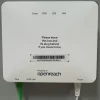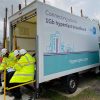A Tale of FTTP Broadband Delays and Availability on Openreach’s UK Network

Imagine you’ve just moved into a house. You’ve done all the checking, so you already know the only viable network operator has listed “full fibre” (FTTP) broadband as being “available” to the property. But on the day of your install, the engineer tells you it needs a dig team and your ISP suggests you might have to wait nearly half a year for it to go live. Oh.. and there’s no other fixed line alternatives.
The situation above is one that Andrew and one of his neighbours from the Lincolnshire village of Sudbrooke have experienced. But it’s also an issue that could become increasingly common as Openreach gradually retires their older copper-line based broadband (ADSL, FTTC / SOGEA etc.) services.
Andrew recently purchased a house in the village, which is currently only served by Openreach’s national network. “Before Fibre [FTTP] was available in the area, I had signed up to the waitlist, and subsequently was informed it was made available [at the] tail end of last year,” said Andrew. Sure enough, a quick test via BT Wholesale’s Checker and his chosen ISP confirmed that the service was available (Stage 1 Install Process).
Advertisement
The BTW checker also confirmed that SOGEA (Fibre-to-the-Cabinet [FTTC / VDSL2]) was still available and that the exchange is not in a current fibre priority programme. But we’ll come back to this later. Needless to say that Andrew placed his order in early March 2025 and waited until the installation date on 1st April. So far, so normal.
Andrew told ISPreview:
“On the day of the install the engineer informed me that it would not be possible to install today and that a dig team would have to come out to dig the road.
I have now been given a date of May 20th for the permissions to be received, and that the work will then enter the queue for the dig. My ISP has informed me that I will probably not be online until July or August.
In the meantime, as I am supposed to be working from home, I have attempted to get a copper connection contract setup, however as the area is “Fibre Ready” I am unable to take out a copper connection.”
The situation appeared to indicate that Andrew might be stuck waiting for five months (longer if we include the original order date) for a working home broadband connection to go live. The situation is clearly far from ideal and assumes there are no other unexpected delays further down the line (this is always a possibility).
On the same day that ISPreview got involved, we noted that Openreach issued a new update to Andrew, which stated that the original engineer had found a “blockage underground that they’ll need to clear before they can connect you, as well as installing new duct“. Arranging such civil engineering work is often a slow process, although the operator did action Andrew’s case to their High Level Complaints team.
At this point we should highlight that the July/August date given by Andrew’s ISP was somewhat of a tentative guesstimate – likely based on the provider’s experience of such incidents. Plenty of ISPs have told us that they have a backlog of installs with long delays due to similar issues, so this is by no means isolated. But these are tricky things to generalise, as every home will have a different set of often unique circumstances.
Advertisement
The situation raises questions over the way that coverage checkers continue to report a service as being “available“, even after it has become clear that it may take a long time to actually deliver. In addition, Andrew’s area is not yet part of the “FTTP Priority Exchange” programme, which means that he should still technically be able to take an FTTC (SOGEA) line until the FTTP goes live. Some ISPs will offer to do this if the delay is big enough.
In practice, most ISPs now only have eyes for FTTP once it’s marked as being “available” and, as Andrew’s experience shows, that can make it difficult for people in his situation to get an alternative installed during the wait for FTTP.
Similarly, you’ll often have to call the ISP to explain the situation if you want FTTC/SOGEA, since these days most online order systems will only present the option for FTTP in areas marked as “available“. This makes sense within the context of copper retirement, but it’s also more confusing for those stuck in a similar boat.
Openreach’s Position
The good news is that Andrew’s wait may now not be as long as first feared. Openreach informed ISPreview that a new duct will need to be laid from the property to the nearest footway box between the customer’s house and the nearest fibre distribution point (CBT). This will involve an extensive amount of complex excavation work (they had to avoid a lot of other utilities). The company’s local contractor, Morrison’s, will be the one doing this.
Advertisement
Openreach states that the civils estimate was created on the 01/04/25 with a required by date set by their planners for 20/05/25, which was then communicated to the ISP. After ISPreview got involved the network operator has now reviewed the partner’s civils estimate and they’re “looking to get this completed before the end of the month“, but at the time of writing (6th April) the original (20th May) date remains intact.
In addition, Openreach noted that one of the reasons why properties in this area were listed as available for a stage 1 install process is because they were shown in their database as being fed by duct. But the operator’s initial engineer visit (i.e. the first install attempt) found this to be incorrect.
At the end of the day, we can’t realistically expect ordinary consumers to be conscious of all the extra details and caveats that can crop up during an installation or what their options are during that situation. But this is not the first time we’ve had to write about such a case (here) and it probably won’t be the last.
Mercifully, the rise in competition means that many other areas now have a choice of more than one broadband network, but sadly Andrew doesn’t live in one of those. On the other hand, delays can and do happen on alternative networks too, often due to similar reasons. Suffice to say, it may be wise not to assume that a new installation will always be completed within a typical 1-2 week wait.
Mark is a professional technology writer, IT consultant and computer engineer from Dorset (England), he also founded ISPreview in 1999 and enjoys analysing the latest telecoms and broadband developments. Find me on X (Twitter), Mastodon, Facebook, BlueSky, Threads.net and Linkedin.























































What a painful experience, internet is becoming and I would say essential utility, internet used to be nice to have, sobering report that some homeowners are going to have a battle to get interned, I do wonder if solutions are deliberately obtuse for the sake of it.
It seems from the article that the main problem was no ducting to the house but the BT database thought there was so that tends to indicate BT have a process problem. How they can easily conform a house has ducting I do not know. They may just be going bt age and if a bewish house assume it has ducting
At least Openreach isn’t trying to charge him ECCs. In Scotland some rural properties are showing FTTP is available but when a customer orders suddenly ECCs are payable and not just a few hundred pounds either. Seems like a convenient way to lock out gov funding available to AltNets while claiming inflated “homes past” on management reports but maybe that’s just me being cynical…
Cases like that often crop up in places across the UK where the home requires a fair bit of additional civil engineering to connect. One of the most common, but not only, reasons is when the house itself sits over 100 metres back from the road where the fibre passes (e.g. a common issue with farms).
But in those cases it’s often possible for the homeowner to mitigate the cost by doing some of the leg work themselves, such as by digging a trench. Such details would need to be discussed with Openreach though, which can sometimes be a slow and tedious experience.
This happens all the time: someone sells land next to their house to a builder, and the builders don’t contact Openreach because they dont want the chargers.
New owners move in and then blame Openreach for not having a new line waiting for them! Especially in villages, where are they meant to find a new service?
The exchange is probably 3km away.
Is there a charge? I thought it was zero for a new development, though whether one house counts I don’t know.
the problems come in what i call the sub 20 plot market — somewhere in that number its not vialble to dpleoy FTTP with out contribution from the developer — if the developer chooses not to contribute you might create a new not spot in an area or community that might not have any not spots
Telcos should not make claims they cannot fulfill. They should be forced to pay compensation..
Whilst it’s clearly wrong in a very complex and historic infrastructure to overcommit on the delivery of a new service, making the infrastructure provider financially responsible would probably result in infrastructure providers covering that risk by refusing to accept orders until they confirm the service can be delivered. Be careful of what you wish for.
This kind of delay is obviously more of an issue where the order is not replacing any existing service that the customer could continue to use in the event of a delay. Perhaps it needs some pragmatism to have more focus on installs where there is no other service to fall back on?
Then they will simply not offer service if there is any doubt. Lots of people who could have got broadband won’t get broadband.
The distribution duct network hasn’t been surveyed and there has been decades of varying practice and often the records (assumes developers did what they said etc) and there hasn’t been any damage by other utilities.
The main issue is whether OR are recording these issues, updating records and proactively addressing other properties affected where they are the only provider.
In most cases for OR or those using their PIA most of the issues are being addressed by the fibre out to the CBT and these issues relate to the lead in. OR appear to be willing to address any issue even it takes time.
If OR were totally in control they could probably flood a location and convert people over to FTTP at the same time but our process is order by order over a long period dependant on the ISPs. In competitive areas its worse because they only want to spend money on those premises they will actually serve going forward.
One of biggest curses for network providers in urban is the conversion of front gardens to parking damaging any duct and presenting issues to laying new FTTP. If that is the case allow for delay regardless of provider unless you go for the coiled VM surface option.
I am wondering why the chosen ISP didn’t immediately offer FTTC as soon as they learned the duct was blocked, even at a different -higher- price.
Blocked ducts can be as unexpected to OR as well as to the customer/ISP, but I think this would have been largely a non-event if the ISP was a bit more pro-active.
Offering a 4G or 5G router in the interim would make more sense.
The same thing happened at my mother’s new address. In September we ordered FTTP, was told ducting needed to be installed, 1st install date was 31st December this went past and nothing happened.
When we contacted Openreach they said our local council had not issued planning permission to dig up a road. Work was finally completed in Feb 2025, we are still awaiting a compensation resolution onto the account.
It’d be interesting to know who the isp was. BT/EE have workarounds where sogea can still be sold in exceptional circumstances. At the very least, a 4G or 5G mobile router should have been offered temporarily and free of charge.
Of course, he might have opted for a budget supplier who don’t provide those options. You pay your money and you take your choice, in those instances.
Maybe the lesson to be learned for benefitting others is to include broadband connection status on the Property Information pack which is part of buying a house (less helpful for a renter, but still could be on the rental offer/contract).
Then the seller would either have to pre-emptively get a connection before the exchange of contracts/completion, or have a cost liability for non-provision for a period if there is a holdup (to cover alternative service possibly degraded from expectations)
Maybe this isn’t currently common, but worth a try; if you don’t ask likely it would not be volunteered.
Is this not the case for all network providers who need customers cold work done?
Our Victorian forbears, who with far less finance, “Management”,technology and only the facility of largely manual labour were able to build a solid infrastructure which has lasted 100 years + (And which withstood, for the most part, the aerial bombardment of WW2), must be widdling themselves with laughter at recent pathetic efforts afforded by the neo-liberal miracle.
Too many people and organisations wishing to operate from their comfort zone the wholetime.
I can answer a few questions, thought I’m not sure whether I should name the ISP
The house is not a new build, it is mid 80s, and the whole cul de sac was built with copper in the foundations, which is why new ducting was needed.
The neighbour referenced had his install months prior, with the same run-around indates, and dig work done. According to OR & Morrison, all houses there will need dig work done per install, but BTW database still has all houses listed as 1 stage.
The ISP is not a budget ISP, they are one of the small, more expensive and recommended ones, however no suggestion to have FTTC was made and no mention of any recompense like other (cheaper) providers are auto-enrolled in. The mobile router option was a non-starter as the speeds were abysmal. Again, not offered by the ISP.
The blocked duct was located on the public footpath, so not due to a drive being redone, but there was clearly work done in that area with the obvious patch job done.
Shaldon?
As a minor update, OR missed all 3 dates of the follow up dig work with no reason provided (after the initial dig work on the 10th). The planning permission then lapsed going into the bank holiday.